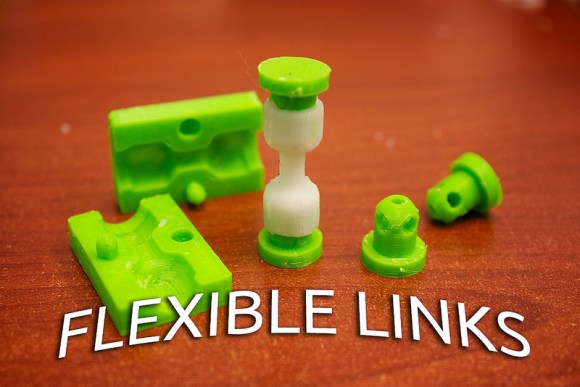Need a custom link that’s strong and flexible? [RobotGrrl] came up with a method of molding flexible links using 3D printed parts and Sugru.
The link consists of two 3D printed hubs, connected by a flexible material cast in a 3D printed mold. [RobotGrrl] recommends using Sugru to create the link, but you can use homemade Oogoo as a low cost substitute. Dish soap is used as a release agent, and prevents the Sugru from sticking to the mold.
The tutorial includes a detailed guide to modeling the parts in Autodesk Inventor, which serves as a quick introduction to the CAD tool. If you just want to make some links, the STL files are available for immediate 3D printing.
Why would you want DIY flexible links? [RobotGrrl]’s Baitbot is a good example. This tentacle robot uses the links as its core. Check out a video of the Baitbot wiggling and jiggling after the break.















Hope you are not trying to use suguru as a flexible rotating joint. it can not handle constant flexing.
It’s RoboBrrd, not RoboGrrl.
That’s the name of her robot, not herself.
From the license declairation at the bottom of the linked page:
“Designed by Erin Kennedy / RobotGrrl for RoboBrrd.com”
[RobotGrrl] is correct.
Make a biological back bone joint and use the suguru as the cushioning disks.
Damn you Sugru! Anyone know of a pourable rubber/castable rubber. Like something you can cast that is equivalent to the rubber in syringes?
The SDM flexible gripper developed at Harvard (and continued at Yale) uses polyurethanes of various hardnesses to create flexible links of this type. They have also experimented with high performance silicones, but I’m told the urethanes work best. The biggest problem is the need to de-gas them before casting, which requires a vacuum chamber
I use silicones from Smooth-On for my molds. Instead of vacuum degassing I use pressure casting. It forces air into solution in the silicone and when it sets it’s permanent. 24 hours at 75 degrees Fahrenheit will ensure it works. At higher temperatures the curing time will be shorter.
Vacuum degassed and poured silicone will still trap bubbles in sharp inside corners and other fine detail. Pressure casting forces the silicone into all fine detail. If your master model is hollow it has to be sealed to the mold form base with an air vent into the inside, or otherwise vented so there’s equal pressure from the air inside the model and the silicone outside.
Did anyone else notice the horrible quality of 3D prints? Erin, you are putting yourself to shame!